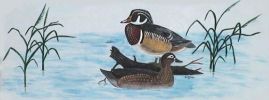Guidelines for Monitoring Wood Duck/Merganser Nest Boxes
By Leif Marking---May 2005
- Houses should be placed well before the nesting season begins in late March.
Our houses are mounted on trees at 10 or more feet from the ground;
high enough to avoid flood water and to discourage people from molesting them.
We use lifters to remove the houses from the tree mount bracket.
- Existing houses should be checked before the nesting season and
bedding restored as necessary.
Poplar wood chip bedding should fill only the bottom half of
container when the eggs are deposited to prevent or discourage raccoon predation.
Replace any wet or soiled bedding.
- Houses should be checked every two weeks during the nesting season or
at least once during incubation to get an accurate count on egg numbers.
Then check soon after hatching to obtain the number escaping the box.
The membrane count should verify the number hatched;
however song birds often carry out some membranes as time passes.
Membranes are usually integrated with bedding and
down so they must be separated to get an accurate count.
Record the numbers of hatched and presumed escaped.
Destroy any remaining eggs at the site and restore nesting material.
- Wood duck eggs are slightly smaller than hooded merganser eggs,
oval in shape, and light brown in color.
They resemble pullet eggs in size and shape.
Their resulting membranes are soft, light colored, quite intact, and
often missing only the cap which often has shell material attached.
Shell material is obvious in small pieces,
but the color fades as the shells age.
- Merganser eggs are larger than wood duck eggs, rounder in shape, and
usually pure white except that some of their egg shells may contain almost
blackish coloration or pigmentation.
Their membranes are soft, light in color, and often more fragmented.
Merganser nests after hatching are distinguished by abundant white shell
fragments that are thick and hard.
They appear almost like oyster shells.
- Often ducks compete for the same nest box, and
several ducks will deposit eggs in the same nest.
Known as nest competition and nest parasitism or in severe cases dump nests,
the dominant hen should be given credit for the number of ducklings produced,
and the egg species numbers can be reflected in the recordings.
- The numbers of eggs and ducklings recorded in your log book should then
be transferred to our BPCA summary forms and delivered to the project manager for
development of the annual report.
Nesting is generally completed by the end of June and reports are due
shortly thereafter.


 gmail.com
gmail.com